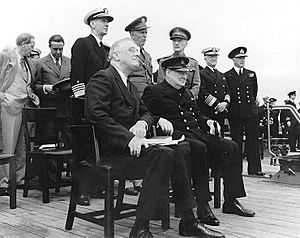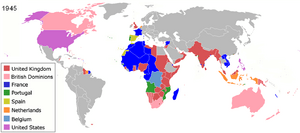Atlantic Charter facts for kids
Quick facts for kids Atlantic ConferenceCodename: Riviera |
|
|---|---|

Franklin D. Roosevelt and Winston Churchill at the Atlantic Conference
|
|
| Host country | |
| Date | 9–12 August 1941 |
| Venue(s) | Naval Station Argentia, Placentia Bay |
| Participants | |
| Follows | First Inter-Allied Conference |
| Precedes | Declaration by United Nations |
| Key points | |
|
Atlantic Charter
|
|
The Atlantic Charter was an important agreement made on August 14, 1941. It was a joint statement by the United States and Great Britain. They shared their goals for what the world should be like after World War II. This happened even before the U.S. officially joined the war.
The charter outlined several key ideas:
- No country should try to take over more land.
- Countries should not change borders without people agreeing.
- People who lost their self-government should get it back.
- Trade should be easier for everyone.
- Countries should work together for better living conditions.
- Everyone should be free from fear and poverty.
- Ships should be able to travel freely on the seas.
- Countries should stop using force against each other.
- Nations that start wars should give up their weapons.
This charter later led to the Declaration by United Nations in 1942. This declaration was a big step towards creating the modern United Nations. The Atlantic Charter also inspired other important agreements after the war. These include the end of the British Empire, the creation of NATO, and the General Agreement on Tariffs and Trade. In 2021, a new version, the New Atlantic Charter, was signed by U.S. President Joe Biden and British Prime Minister Boris Johnson.
Contents
- Why Was the Atlantic Charter Created?
- How Did the Atlantic Charter Get Its Name?
- How Was the Charter Accepted by Other Nations?
- How Did the Charter Affect the Axis Powers?
- What Was the Charter's Impact on Empires?
- Who Participated in the Conference?
- The Atlantic Charter Today: 2021 Revitalization
- See Also
Why Was the Atlantic Charter Created?
Before the Atlantic Charter, the Allies of World War II shared their ideas for the world. This happened in June 1941 with the Declaration of St James's Palace. Then, in July 1941, Britain and the Soviet Union formed an alliance.
U.S. President Franklin D. Roosevelt and British Prime Minister Winston Churchill met in August 1941. They met during the Atlantic Conference in Placentia Bay, Newfoundland. On August 14, 1941, they announced their joint declaration. This happened at the U.S. naval base there, Naval Base Argentia. The U.S. had recently leased this base from Britain. The U.S. did not join the war until the attack on Pearl Harbor four months later.
The Atlantic Charter was not a formal legal document. It was a statement of goals for the war and the world afterward. Many of its ideas came from the belief that Britain and America should work together. Roosevelt wanted Britain to agree on war goals. Churchill desperately wanted the U.S. to join the war effort. These reasons helped lead to the meeting. Both leaders traveled in secret for this important meeting.
On August 9, 1941, Churchill's ship, HMS Prince of Wales, arrived in Placentia Bay. It met Roosevelt's ship, USS Augusta. When they met, Churchill said, "At long last, Mr. President." Roosevelt replied, "Glad to have you aboard, Mr. Churchill." Churchill then gave Roosevelt a letter from King George VI.
How Did the Atlantic Charter Get Its Name?
When the statement was released on August 14, 1941, it was called "Joint Declaration by the President and the Prime Minister." People often called it the "Joint Declaration." A British newspaper, the Daily Herald, first used the name Atlantic Charter. Churchill later used this name in the British Parliament. Since then, everyone has called it the Atlantic Charter.
There was no signed paper copy of the Atlantic Charter. The leaders worked on several drafts. The final text was sent by telegram to London and Washington, D.C. Roosevelt shared the charter's ideas with Congress on August 21, 1941. He later said there wasn't one single "Atlantic Charter" document. He explained that the closest thing was the radio messages between the ships.
How Was the Charter Accepted by Other Nations?
The Allies quickly supported the charter. On September 24, 1941, many governments-in-exile met in London. These were leaders from countries like Belgium, Czechoslovakia, Greece, and Poland. The Soviet Union and Free French Forces also joined. They all agreed to follow the principles set by Britain and the United States.
On January 1, 1942, an even larger group of nations signed the Declaration by United Nations. This declaration showed their strong unity against Hitler.
How Did the Charter Affect the Axis Powers?
The Axis powers, especially Japan, saw these agreements as a threat. In Tokyo, the Atlantic Charter made Japanese leaders push for a stronger approach against the United States and Britain.
The British dropped millions of leaflets over Germany. These leaflets used the charter to tell Germans that peace would not be harsh. They promised that Germany could have peace and wealth again. The charter was an important step towards forming the United Nations. It showed that countries with different views could agree on international goals.
What Was the Charter's Impact on Empires?
The charter's ideas caused problems for countries that had empires. These included the United Kingdom, France, the Soviet Union, and the Netherlands. These countries did not want to give up their colonies.
At first, Roosevelt and Churchill seemed to agree that the charter's idea of self-determination would not apply to Africa and Asia. But soon, people in places like India and Indonesia wondered if the charter applied to them too. Since the war needed the help of these allies, Roosevelt decided to put some pressure on Britain. However, he postponed the issue of colonial self-determination until after the war.
Impact on the British Empire
The idea that all people had a right to choose their own government gave hope to leaders in British colonies. Historians say the Atlantic Charter helped start the movement for independence.
Americans believed the charter meant the war was fought for self-determination. But Churchill said in September 1941 that the charter only applied to countries under German control. He argued it did not apply to parts of the British Empire. Churchill and other British leaders said that British colonies never had "sovereign rights." So, there was no original government to restore.
Churchill did not want the charter to apply to places like British India. Mahatma Gandhi wrote to Roosevelt in 1942. He said the Allies' claim of fighting for freedom sounded empty when India was still exploited by Britain. Roosevelt believed in self-determination. But he did not want to pressure the British too much about India. The U.S. was not officially in the war yet. Gandhi refused to help the British or American war effort. Roosevelt chose to support Churchill. However, about 2.5 million men from British India volunteered to fight for the Allies. This was the largest volunteer force ever.
Impact on Poland
Churchill was not happy about including self-determination in the charter. He saw it as a temporary statement of war goals. The Polish government-in-exile worried about this part of the charter. They thought it might stop Poland from taking land from Germany. This led Poland to ask Britain for a flexible interpretation of the charter.
Impact on the Baltic States
During the war, Churchill wanted the charter to allow the Soviet Union to keep control of the Baltic states. The United States disagreed with this until March 1944. The U.S. did not recognize the Soviet takeover of the Baltic states. But they did not push the issue with Stalin while he was fighting Germany. Roosevelt planned to discuss the Baltic issue after the war. However, he died in April 1945.
Impact on Morocco
The Atlantic Charter was also used by Moroccan nationalists. They used it to demand independence. Like many other groups in Asia and Africa, Moroccan anti-colonial groups saw the charter as a call for freedom. They used it to demand an end to French and Spanish colonial rule.
Who Participated in the Conference?
The main participants in the Atlantic Conference were:
- President Franklin D. Roosevelt
- Admiral Ernest J. King
- Admiral Harold R. Stark
- General George C. Marshall
- Major General Henry H. Arnold
- Presidential adviser Harry Hopkins
- Special envoy to Europe W. Averell Harriman
- Prime Minister Winston Churchill
- General Sir John Dill
- Admiral Sir Dudley Pound
The Atlantic Charter Today: 2021 Revitalization
On June 10, 2021, a new version of the Atlantic Charter was issued. U.S. President Joe Biden and U.K. Prime Minister Boris Johnson signed it in Cornwall, England. The White House said this new "revitalized" Atlantic Charter aims to meet "new challenges of the 21st century." It also builds on the promises made eighty years ago.
See Also
- Allied technological cooperation during World War II
- Allies of World War II
- Diplomatic history of World War II
- Fourteen Points
- History of the United Nations
- List of Allied World War II conferences
- Tizard Mission
- United Kingdom–United States relations




